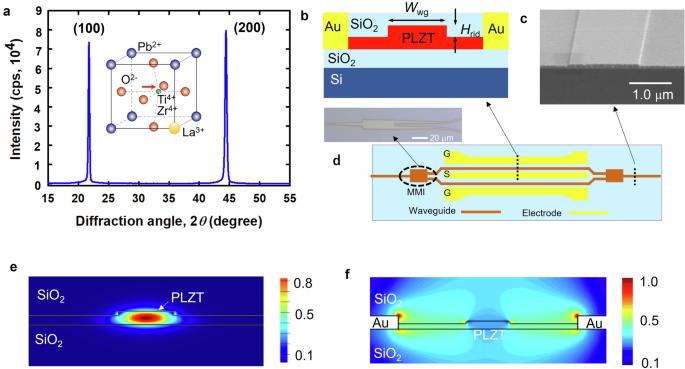Ultra-fast perovskite electro-optic modulator and multi-band transmission up to 300 Gbit s−1
IF 7.5
Q1 MATERIALS SCIENCE, MULTIDISCIPLINARY
引用次数: 0
Abstract
The gap between the performance of optoelectronic components and the demands of fiber-optic communications has narrowed significantly in recent decades. Yet, the expansion of data communications traffic remains substantial, with fiber-link speeds increases anticipated in the near future. Here, we demonstrate an ultra-high-speed electro-optic waveguide modulator constructed using a thin film of lanthanum-modified lead zirconate titanate with a ferroelectric phase exhibiting a strong Pockels effect. The modulator has a wide optical window; thus, the modulation was demonstrated for 1550 and 1310 nm wavelengths. This device showed electro-optical intensity signaling with line rates of 172 Gbit s−1, in conjunction with on–off keying modulation; this performance could be increased to 304 Gbit s−1 using four-level pulse modulation. The signaling performance of this modulator was found to be robust, with stable performance at temperatures as high as 100 °C. This technology is expected to have applications in a wide range of classical optoelectronic devices and in quantum science and technology. Advanced fiber-optic communications rely on electro-optic materials with suitable properties. Here a perovskite oxide, lanthanum-modified lead zirconate titanate, is used to fabricate a waveguide modulator with line rates as high as 304 Gbit/s using four-level pulse modulation.

超高速包晶电光调制器和高达 300 Gbit s-1 的多波段传输
近几十年来,光电元件的性能与光纤通信需求之间的差距已大大缩小。然而,数据通信流量仍在大幅增长,预计在不久的将来光纤链路的速度也会提高。在此,我们展示了一种超高速电光波导调制器,该调制器采用了镧改性锆钛酸铅薄膜,其铁电相位具有很强的波克尔斯效应。该调制器具有较宽的光学窗口;因此,在 1550 和 1310 nm 波长下均可进行调制。结合通断键控调制,该设备显示出线路速率为 172 Gbit s-1 的电光强度信号;使用四级脉冲调制,这一性能可提高到 304 Gbit s-1。研究发现,这种调制器的信号传输性能十分稳定,在高达 100 °C 的温度下也能保持稳定。这项技术有望广泛应用于经典光电器件和量子科技领域。先进的光纤通信依赖于具有合适特性的电光材料。在这里,一种包晶氧化物--镧改性锆钛酸铅--被用来制造波导调制器,利用四级脉冲调制,线路速率高达 304 Gbit/s。
本文章由计算机程序翻译,如有差异,请以英文原文为准。
求助全文
约1分钟内获得全文
求助全文
来源期刊

Communications Materials
MATERIALS SCIENCE, MULTIDISCIPLINARY-
CiteScore
12.10
自引率
1.30%
发文量
85
审稿时长
17 weeks
期刊介绍:
Communications Materials, a selective open access journal within Nature Portfolio, is dedicated to publishing top-tier research, reviews, and commentary across all facets of materials science. The journal showcases significant advancements in specialized research areas, encompassing both fundamental and applied studies. Serving as an open access option for materials sciences, Communications Materials applies less stringent criteria for impact and significance compared to Nature-branded journals, including Nature Communications.
文献相关原料
| 公司名称 | 产品信息 | 采购帮参考价格 |
|---|
 求助内容:
求助内容: 应助结果提醒方式:
应助结果提醒方式:


